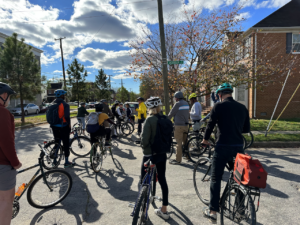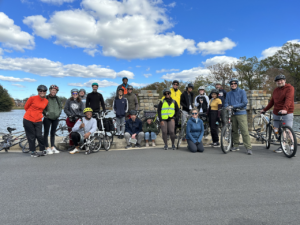Bicycling for Climate Justice in Richmond, VA

Editor’s note: This post was written by P2P Climate Ambassador Richard Sebastian describing a community action he organized to highlight the issue of climate justice. It is being provided as a model that you can replicate in your community to help your neighbors better understand the inequitable impacts of climate change and encourage them to support policies to address it.
It was a cold, crisp November morning when I and 20 other bicyclists set off from our meeting location in the Randolph neighborhood of Richmond, Virginia and headed to the first stop on the 5-mile loop of the Riding the Redlined Climate Justice Bike Tour. The Randolph neighborhood was the perfect location for this inaugural bike tour, organized with support and funding from the Chesapeake Climate Action Network (CCAN) and the Sierra Club of Virginia. Randolph is a longstanding and thriving Black community that, like other communities of color in Richmond, has faced decades of neglect, racist policies, “redlining”, and “urban renewal”. The tour was an opportunity for participants to experience – in a sustainable way – the local impacts of climate change and the need for climate justice by connecting Richmond’s history of racism to current inequitable outcomes in health, lifespan, and quality of life in formerly redlined neighborhoods.
Joining us on the tour to share his expertise was Dr. Rob Nelson, the University of Richmond professor who led the award-winning Mapping Inequality project that documents the once-common practice of redlining in cities across the United States. Redlining was the practice of assigning grades, partly determined by the racial and ethnic identity and class of residents, to neighborhoods that reflected their ‘mortgage security’. According to Mapping Inequality, “these grades were visualized on color-coded maps, with neighborhoods receiving the highest grade of A – colored green on the maps – deemed minimal risks for banks and other mortgage lenders, while those receiving the lowest grade of D, colored red, were considered ‘hazardous.’ These grades made it difficult or impossible for those living in redlined neighborhoods to access mortgage financing and thus become homeowners, and directed both public and private capital to native-born white families and away from African American and immigrant families.”

The wealth inequalities created by redlining 80 years ago were still evident as we made our way along the streets of Randolph, as were signs of the community’s resilience. We stopped to admire Riverview Baptist Church, one of only a few buildings designed by Black architect Charles Thaddeus Russell that had not been razed, and rode beside Richmond’s Downtown Expressway, a destructive urban renewal project that cut the Randolph neighborhood in half. The Expressway also contributes to the area’s lower air quality. We visited the Amelia Street School Meadow project, a learning project to “re-meadow” a school lot with native and heat-resistant plants and trees to reduce the summertime heat in Randolph, which has less tree cover than in other, more affluent areas of the city. We rode out of Randolph past the once “whites-only” tennis courts on what is now Arthur Ashe Boulevard, named after the tennis champion and Richmond native, and ate lunch at the Byrd Park Pump House, one of the coolest locations in the city as measured by the Virginia Urban Heat Island Study that mapped temperature and air quality differentials in the city. Riders also conducted their own urban heat island study, measuring air quality and temperature along the route by mounting sensors, provided by the Science Museum of Virginia, to our bicycles.

The Riding the Redlined Climate Justice Bike Tour was the first in a series of climate-themed bike tours planned for Richmond, with each tour highlighting a different topic or theme: local electrification infrastructure, urban farming, environmental justice projects, and of course, bicycle infrastructure, all with a focus on climate justice. The bike tour model is a great way to make the impacts of climate change more immediate and personal when people see how it affects their neighbors and local communities, and how their support of local policies and projects can help create greener, healthier, and more equitable communities. However, it is critically important when organizing an event focused on equity and climate justice to actively involve those in the affected communities. For Riding the Redlined, we invited LaToya Gray-Sparks, a faculty member at Virginia Commonwealth University who had published a case study called Reconstructing Randolph and was intimately familiar with the neighborhood and its history, to co-lead the tour to share her expertise with participants. While she was unable to join us for the tour, she was an integral part of the tour planning, identifying locations, notable figures, and events of interest along the route.
About the Author
Richard Sebastian, P2P Climate Ambassador, activist, and educator based in Richmond, Virginia
Additional Resources
American Climate Leadership Awards 2023 Broadcast Recording
ecoAmerica American Climate Leadership Awards Replication Guides
